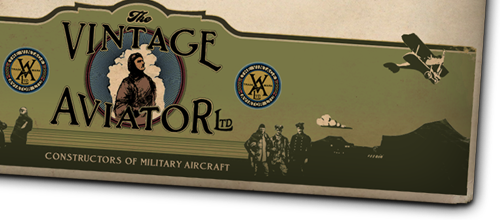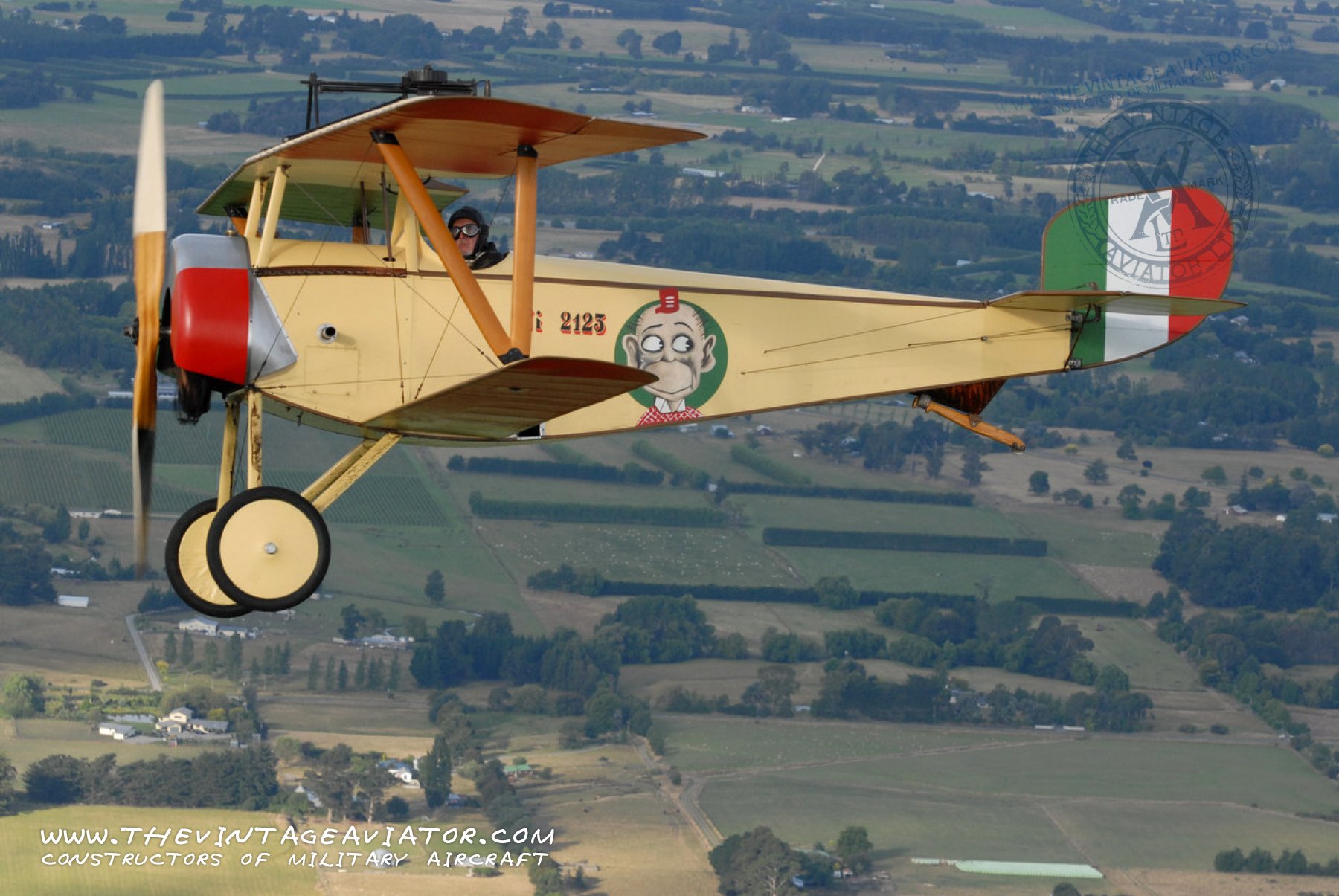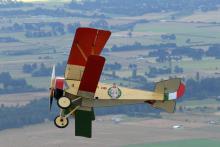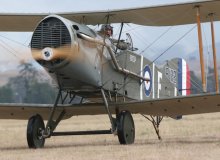You are here
Nieuport 11 Bebe
Used by the British and French to counter the fokker “eindecker“ scourge in 1916 it was seriously disadvantaged since it had no interrupter gear to allow the machine gun to fire through the prop arc."
Built By Walt Addems and Joe Pfeifer 7/24/62 Porterville CA. Joe Pfeifer was noted for building several aircraft, two nieuport 11’s a sopwith snipe and several other homebuilt aircraft of his own design. And many restorations. The second N11 hangs in the air and space museum in San Diego California. Used by the British and French to counter the fokker “eindecker“ scourge in 1916 it was seriously disadvantaged since it had no interrupter gear to allow the machine gun to fire through the prop arc. Ni 2123 represents an Italian built nieuport . mfg 1917 under license by maachi it was assigned to 80a squadriglia italian air service in may of that year. This aircraft became the personal mount of sgt. Alvaro leonardi who survived the war with 8 victories
The plane was the personal plane of Italian ace ALVARO LEONARDI assigned to 80° Squadriglia Caccia based at Aiello airport near Udine in Friuli region on february 1917. Leonardi scores in total 8 confirmed victories flying Nieupor 11 and 17 and Hanriot HD1. With the Ni 11 sn2123( a Macchi licensed built plane) scored only one victory, the 24 may 1917. That day he took off from Cascina Farello airfield ( another airfield used by the Squadriglia) for a cover flight of some allied ship when the formation was attacked by Austro Hungarian seaplane fighters ( probably Lohner L136) commanded by Austrian Aces Gottfried Banfield. Leonardi attacked one of the seaplane and he shooted it down near Panzano gulf area. It was the only aerial victory scored with Nieuport 11 2123.
Color Scheme
The colors scheme is based on the italian version of the “happy hooligan” comic strip in which this character is called fortunello ( which means lucky). I have had the good fortune to be able to fly two rotary powered Nieuport 11’s. Thanks to the efforts of an energetic collector and builder of early aircraft, Cole Palen and his good friends Gordon and Kay Bainbridge I was able to fly my first Nieuport 11 replica powered by an 80 Hp LeRhone engine. The Second Airplane is the Addems / Pfeifer Built airplane also powered by an original LeRhone rotary engine.
Because there was a prewar monoplane with the company designation XI the new single seat biplane produced by the nieuport company in 1915 was designated XIB. This design was very similar to the earlier Nieuport 10 but much smaller in size. The prototype first appeared in the summer of 1915. The first Nieuport 11 to reach an operational unit was delivered to ESCADRILLE N.3 on January 5, 1916. The design was one of many from a long line of successful nieuport fighters. Many of the early Nieuport biplanes were in the V-strut sesquiplane configuration, the lower wings have a single spar, necessitating the familiar “V’ wing struts. The wings utilize a rather thin airfoil section with a sharp leading edge. There is no vertical stabilizer only a rudder. The aileron control is achieved by a rather clever horn and pushrod arrangement.
French and British were not the only operators or builders of this design, Belgians, Italians and Russians also flew this type. Italians, Russians and Japanese built it under license and even the Germans copied it. The little nieuport nicknamed Bebe was well received and a favorite of many pilots. The most common armament was a single Hotchkiss or Lewis gun mounted above the pilot on the upper wing, although a few were equipped with Le Prieur incendiary rockets. The rockets were launched from tubes mounted to the wing struts. Considered outdated after only a year of service, it continued to function as a trainer and scout for many years.
The cockpit is noticeably diminutive and simple, with only a tachometer, Zenith height gauge and an airspeed indicator for instrumentation. The lack of instrumentation seems to bother more modern pilots; I prefer to say there is less cause for alarm. A single Lewis gun is mounted to the upper surface of the top wing, today only creating a hazard to the pilot’s skull when trying to get into the rather small cockpit, (actually it usually gets the pilot on the way out of the cockpit when he is least suspecting). Once seated it is obvious that there is not a lot of room here, shoulders almost touching both upper longerons, feet on a single rudder bar, control stick in the right hand and air and fuel controls at the left. When wearing a winter flying coat and a parachute the modern pilot feels a little like a cork in a champagne bottle.
The fuel and oil tanks are located under the forward cowling. The oil tank holds about two and a half gallons of Castor oil to supply the rotary engines total loss oil system (ten pints per hour are consumed by the LeRhone) there are no oil pressure or temperature gauges. With this oil system it is imperative that the pilot check for bluish/white smoke in the exhaust indicating the engine is getting oil. There is a “pulsator”(a glass bulb filled part way with oil leaving a compressible air space that shrinks and swells at a rate dependent on the oil pump speed) in the cockpit that can be used to measure engine speed and oil pump operation.
The Engine
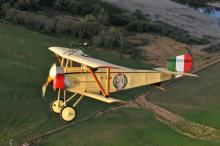 One of the most interesting parts of this airplane is the 80 hp LeRhone rotary engine. State of the art in it’s day and very unusual today; the entire engine spins with the propeller. Company brochures even claimed that the spinning effect could deflect bullets! It is true that they were able to continue running even with a damaged cylinder or two. Gyroscopic forces generated by this rotating 300 lb mass produce some very distinct handling characteristics. Full throttle is reached at 1200 rpm with a huge 108 inch prop. This wonderful powerplant was small, compact, and reliable for it’s day. Smoother running than many horizontally opposed engines and relatively quiet (it makes a distinctive “whoosh” sound). Controls for the engine consist of an air valve and a fuel valve, which must both be manipulated by the pilot to provide the correct mixture at a given throttle setting. With such cantankerous controls it is easier to throttle the engine in combat by “blipping” it on and off with the ignition. To add to this complexity the French used unconventional controls; to open the fuel or air valve you pull the levers toward you, difficult when you consider, most aircraft require the pilot to push the throttle control in for full throttle.
One of the most interesting parts of this airplane is the 80 hp LeRhone rotary engine. State of the art in it’s day and very unusual today; the entire engine spins with the propeller. Company brochures even claimed that the spinning effect could deflect bullets! It is true that they were able to continue running even with a damaged cylinder or two. Gyroscopic forces generated by this rotating 300 lb mass produce some very distinct handling characteristics. Full throttle is reached at 1200 rpm with a huge 108 inch prop. This wonderful powerplant was small, compact, and reliable for it’s day. Smoother running than many horizontally opposed engines and relatively quiet (it makes a distinctive “whoosh” sound). Controls for the engine consist of an air valve and a fuel valve, which must both be manipulated by the pilot to provide the correct mixture at a given throttle setting. With such cantankerous controls it is easier to throttle the engine in combat by “blipping” it on and off with the ignition. To add to this complexity the French used unconventional controls; to open the fuel or air valve you pull the levers toward you, difficult when you consider, most aircraft require the pilot to push the throttle control in for full throttle.
Starting the Le Rhone is a relatively simple procedure provided you have several friends. First the aircraft must be moved to the flight line with some sort of dolly because it has only a tailskid, then chocked in this position, it has no brakes, once readied it is a good idea to have two people hold back on the struts, starting at more than an idle is inevitable. Another person is needed to prime the engine through the exhaust ports or alternately swing the propeller in an attempt to “windmill” the engine to suck in the intake charge. This same person can take control of the fire extinguisher and oversee the entire operation while the starter grasps the propeller to swing it in the “Armstrong” fashion. Once started, the engine is allowed to warm up for a few minutes and then adjusted for maximum rpm. Sound is a great indication of the condition of the engine; a raspy crackling sound usually means a lean mixture, a muffled sluggish tone would indicate an overly rich mixture. When satisfied with the correct settings the engine is idled by “blipping” the ignition on and off with a switch on the control stick.
"Starting the Le Rhone is a relatively simple procedure provided you have several friends..."
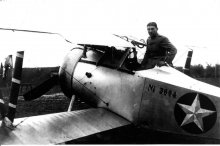
Take-off roll is less than 400 feet with a modest amount forward stick from the start. The tail comes up right away and a little rudder is needed to keep the nose pointed down the runway. No need to look at the airspeed indicator on the strut, it would be a distraction. From experience you can sense when the airplane is ready to fly and a little backpressure initiates a welcome climb away from the narrow runway. Indicating about 60 mph on climb-out the nieuport becomes very controllable and well mannered, enough for the pilot to look around smile and realize that this is a very special flight. As with many WWI types the nieuport is tail heavy and requires a fair amount of forward stick to maintain level flight. The ailerons are relatively heavy and create a large amount of adverse yaw. The tiny airplane is relatively stable in calm air but Every now and then Mother Nature gets involved and provides for thrilling flights, the little nieuport weighs less than 1000 lbs and gets bounced around quite a bit in rough air, without brakes and fitted with a tailskid landing into the wind is a must. Braking action is provided by the metal tailskid that digging into the runway, full “back” stick is used to keep the skid in contact with the ground and to slow the airplane as soon as possible. This is the time when the airplane must be kept on course because even the slightest weave one way or the other can cause a ground loop.
Most rotary powered airplanes climb when turned to the left and dive when turned to right due to the gyroscopic forces (characteristics that could be advantageous to an experienced pilot. At 1100 rpm the cruise speed is about 85 mph I could never outrun a faster more maneuverable Albatros at that speed. Although the climb rate is less than spectacular the nieuport is fairly agile, although a lot of control input is necessary and coordination is a must. Speed control is relatively easy with the rotary engine and the “blip” switch (more formally; the coupe’ button) when the ignition is cut the rotating engine and large prop slow to provide more of a braking effect than a gliding one.
Flying behind a rotary engine in a fighter
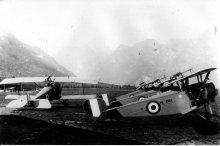
In flight you become aware of how important the rudder is and not just the ailerons. The full flying rudder and the lack of a vertical stabilizer allow the airplane to easily fly in a skidding attitude. Just resting your feet unevenly on the rudder bar will cause the airplane to fly untrimmed through the air. Rudder feel is very light but amazingly effective. The first flight I made in this airplane was thrilling. Finally doing it! Flying behind a rotary engine in a fighter. It was also somewhat dismaying to realize how uncoordinated and sloppy I could be. You must fly this airplane all of the time, from run-up, to taxi and take off, even in cruise the airplane requires control inputs for engine operation and rudder to keep the airplane on course. The Bebe is fun to fly and has a personality all it’s own.
Flights are generally kept to fifteen minutes, although, I have flown the Bebe for close to an hour during filming for a documentary without any ill effects from the castor oil fumes (It is rumored that not all forced landings were due to mechanical failures in these early machines). Almost all of these early airplanes are “slipped in”, there are no flaps and the forward visibility is poor, by slipping the airplane the pilot can control the descent easily while keeping the runway and touchdown point in sight. Once over the runway and the nose is brought up to flare the forward visibility is practically nonexistent. Most of these WW1 types are short field airplanes, after touchdown the Nieuport only rolls a few hundred feet.
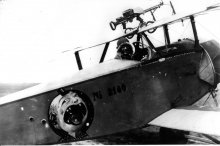
Fire is a serious concern when “blipping” the engine on and off during a flight and especially during landing. In order to descend power is reduced by “blipping” the engine more off than on. Fuel is gravity fed from the tank to the engine and continues to flow into the engine regardless of “blip” switch position, if the fuel valve is not closed or the engine is kept off for extended periods the fuel expelled from the exhaust port can accumulate inside the cowling and ignite when the engine is switched back on. Oil fouling is another problem; with single ignition the spark plugs can become oil fouled very easily.
This is truly “seat of the pants” flying. The pilot uses all of his senses to help operate this machine. The lack of instrumentation is not a handicap, once you become familiar with other indicators. Everything from the smell of burnt castor oil to the sight of small oil droplets on the leading edges of the wing indicate the oil system is working, vibration could mean one spark plug is fouled and needs to be cleared, wind on your cheek means the turn is not coordinated or the airplane is skidding etc.
"As an early entrant into the great war the “Bebe” would be no match for any of the later designs but it is still is a sight to behold.
